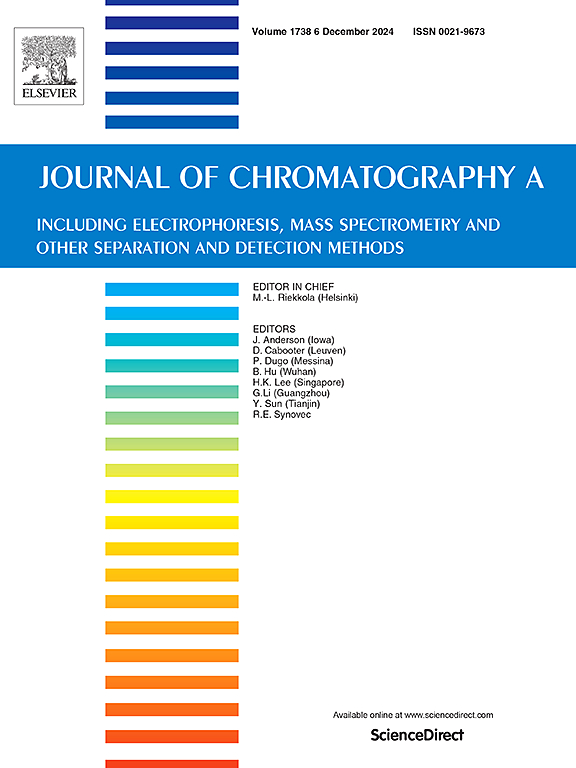电子烟蒸发过程中CBD、CBDA和Δ9-THC的热转化:转化产物的GC-MS鉴定
IF 4
2区 化学
Q1 BIOCHEMICAL RESEARCH METHODS
引用次数: 0
摘要
电子烟(电子烟)的使用在世界范围内受到欢迎,因为它减少了吸食大麻的难闻气味和味道。然而,由于电子烟加热线圈的高蒸发温度,大麻素可能转化为二次大麻素产品,可能造成意想不到的心理和有害影响。为了研究大麻素在电子烟蒸发过程中的热转化,制备了一种撞击气溶胶收集装置,并根据线圈功率、药筒油和收集溶剂的变化对收集条件进行了优化。当线圈功率从45 W增加到105 W时,对电子药筒液中单个大麻二酸(CBDA)、大麻二酚(CBD)和Δ9-tetrahydrocannabinol (Δ9-THC)进行热转化。收集的气溶胶溶液用三甲基硅基试剂衍生化,采用气相色谱-质谱(GC-MS)扫描模式进行分析。根据电子烟线圈功率的变化,研究了个体大麻素的热蒸发特性。在电子烟CBDA蒸发过程中,大部分酸性CBDA通过热脱羧转化为中性CBD,并进一步降解生成多种热产物。从CBDA和CBD的蒸发过程中观察到几个有趣的精神活性Δ8-iso和Δ9-THC异构体,以及大麻色胺(CBC)和CBD醌(CBDQ)。在Δ9-THC雾化的情况下,通过热还原和氧化产生具有精神活性的六氢大麻酚(HHC)衍生物和大麻酚(CBN)。通过比较正品标准品的保留时间和质谱,并对其质谱进行解释,确定了这些热产物。随着线圈功率从45w增加到105w,大多数热产物的数量都有所增加。相反,潜在有害的CBDQ在45 W时最高,并随着线圈功率的增加而降低。根据剖面数据和鉴定结果,提出了大麻素在蒸发过程中的热转化途径。本研究将为大麻油电子烟热转化产物的形成机制提供重要信息,并为大麻油电子烟雾化风险评估提供基础指导。本文章由计算机程序翻译,如有差异,请以英文原文为准。
Thermal transformation of CBD, CBDA, and Δ9-THC during e-cigarette vaping: Identification of conversion products by GC–MS
The use of electronic cigarettes (e-cigarettes) has gained popularity worldwide for reducing the unpleasant odors and flavors of smoking marijuana. However, due to the high vaporization temperature of the heating coil in e-cigarettes, cannabinoids could be converted into secondary cannabinoid products, potentially causing unintended psychological and harmful effects. A lab-built impinger and aerosol collection device was prepared to study the thermal transformation of cannabinoids during e-cigarette vaping, optimizing collection conditions according to variations in coil wattage, cartridge oil, and collection solvents. Thermal conversion of individual cannabidiolic acid (CBDA), cannabidiol (CBD), and Δ9-tetrahydrocannabinol (Δ9-THC) in e-cartridge liquid was performed with increasing coil power from 45 W to 105 W. Collected aerosol solution was derivatized with trimethylsilyl reagents and analyzed by gas chromatography-mass spectrometry (GC-MS) scan mode. Thermal vaping profiles of individual authentic cannabinoids were studied according to the variation of coil power of the e-cigarette. During the CBDA vaping process of the e-cigarette, most of the acidic CBDA was converted to neutral CBD through thermal decarboxylation and further degraded to produce several thermal products. Several interesting psychoactive Δ8-iso and Δ9-THC isomers, and cannabichromene (CBC) and CBD quinone (CBDQ) were observed from the vaping process of CBDA and CBD. In the case of Δ9-THC vaping, psychoactive hexahydrocannabinol (HHC) derivatives and cannabinol (CBN), were produced via thermal reduction and oxidation. These thermal products were identified by comparing retention times and mass spectra of authentic standards and interpreting their mass spectra. The amounts of most thermal products were increased with increasing coil power from 45 W to 105 W. In contrast, potentially harmful CBDQ was found to be highest amount at 45 W and decreased with increasing coil power. From the profile data and identification results, thermal transformation pathways of cannabinoids during the vaping process are proposed. This study will provide important information on the formation mechanism of thermal conversion products and basic guidance for risk assessment of Cannabis oil vaping by e-cigarette.
求助全文
通过发布文献求助,成功后即可免费获取论文全文。
去求助
来源期刊

Journal of Chromatography A
化学-分析化学
CiteScore
7.90
自引率
14.60%
发文量
742
审稿时长
45 days
期刊介绍:
The Journal of Chromatography A provides a forum for the publication of original research and critical reviews on all aspects of fundamental and applied separation science. The scope of the journal includes chromatography and related techniques, electromigration techniques (e.g. electrophoresis, electrochromatography), hyphenated and other multi-dimensional techniques, sample preparation, and detection methods such as mass spectrometry. Contributions consist mainly of research papers dealing with the theory of separation methods, instrumental developments and analytical and preparative applications of general interest.
 求助内容:
求助内容: 应助结果提醒方式:
应助结果提醒方式:


